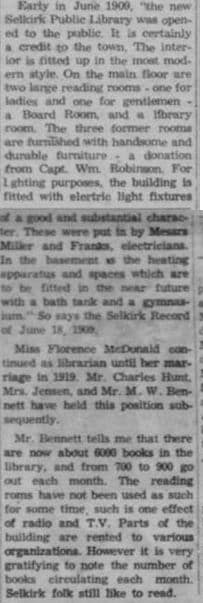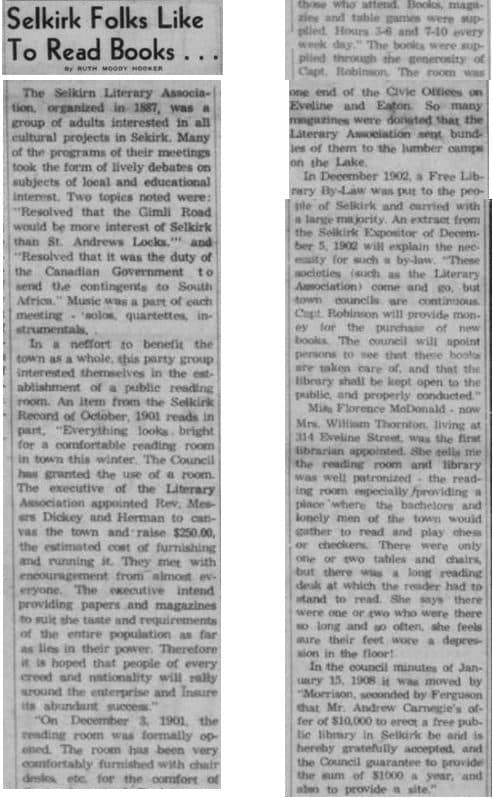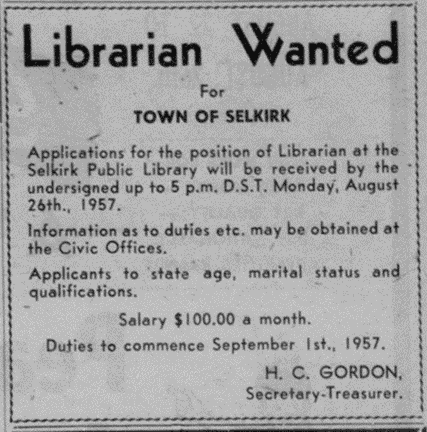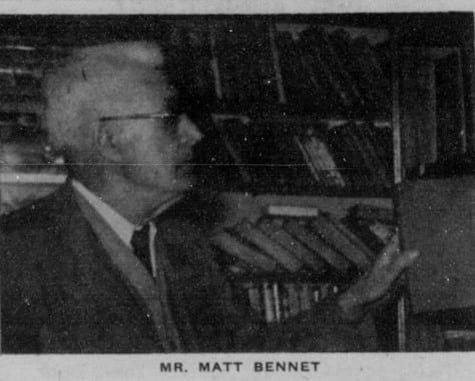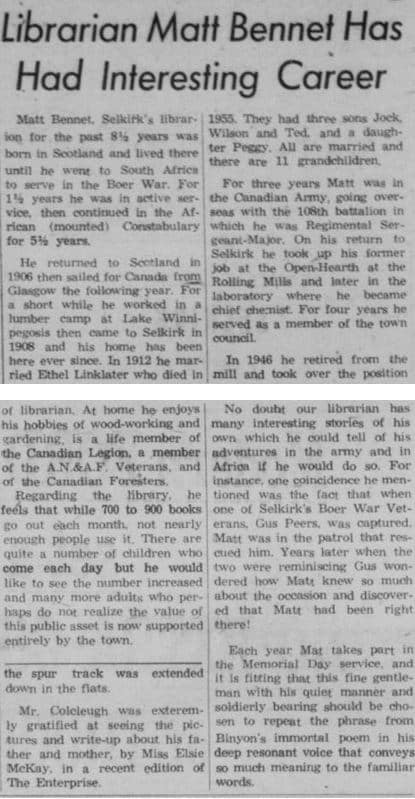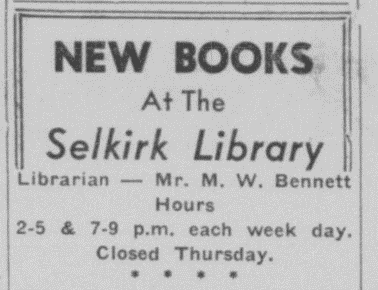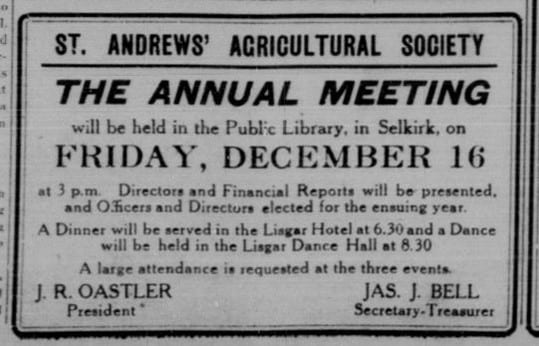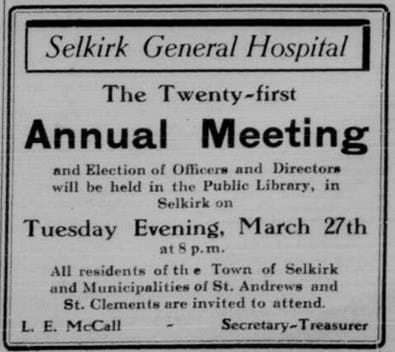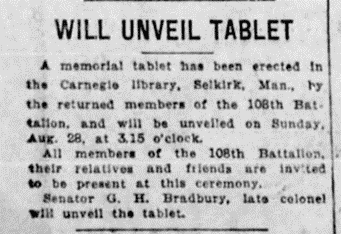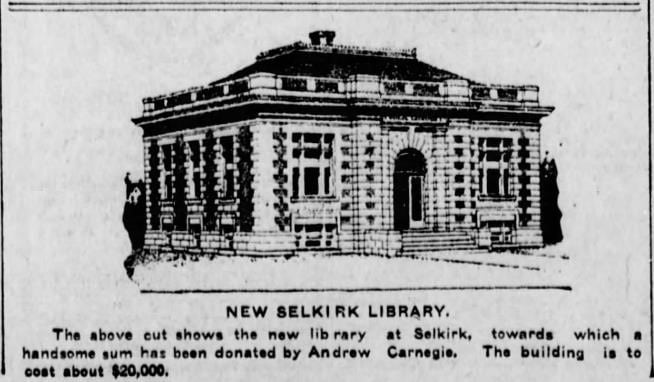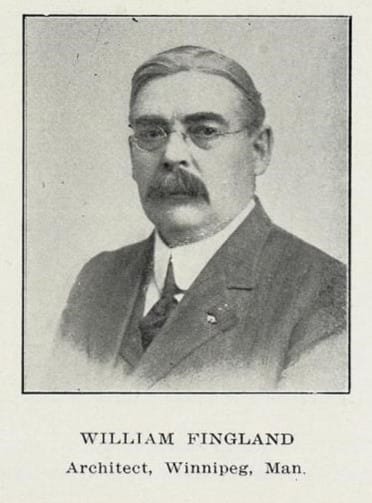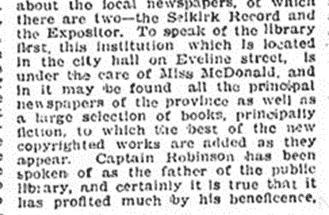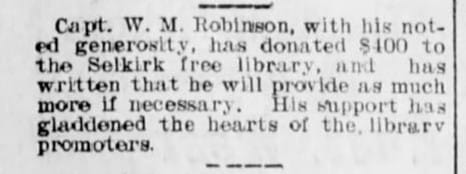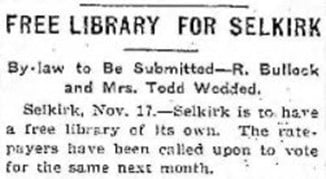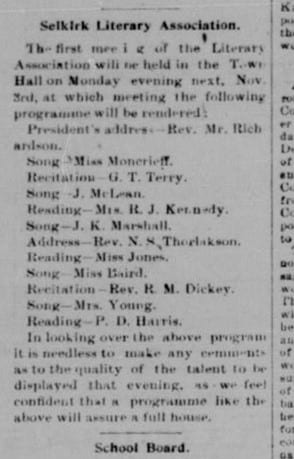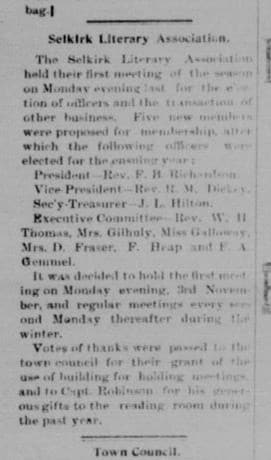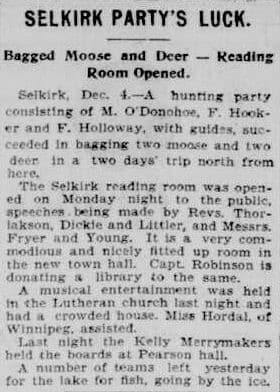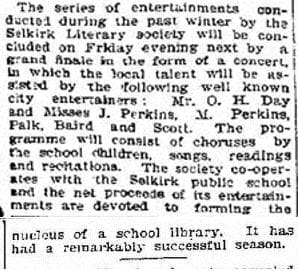Library and Reading Room
A citizens group called the Selkirk Literary Association was established around 1879, primarily to bring speakers to the town and to host debates. One topic in August 1879 was ‘…be it resolved that Canada is a better field for immigrants than the United States.’. The society is mentioned sporadically through the 1880s, which suggests that some years it was more active than others.
In 1900 -1901, the organization was in full stride under president Rev. N. Hennan. Aside from the usual speakers and debates, it hosted a series of winter concerts to raise money for Central School’s first library collection.
More fundraising events were held, and Captain William Robinson donated many of its first 100 books as well as numerous journals and magazines
The reading room and library opened on Monday, December 2, 1901 in a room inside the town office described as “…commodious and nicely fitted up…” with a couple of tables for readers.
Rev. Neil Herman of Portage la Prairie stayed with friends at Selkirk over the Christmas holidays in 1901 and was impressed by what he saw.
“I hope that other smaller western towns will follow the example of Selkirk,” Herman said to a Winnipeg reporter, “in the establishment of free reading rooms (and) free libraries.”
In April 1902, Miss Florence McDonald was appointed caretaker of the reading room and library, making her the town’s first librarian. The library was open weekdays from 3:00 pm to 6:00 pm, and from 7:00 pm to 10:00 pm.
Both the town and literary society agreed that to properly staff and maintain the library collection in the long term, it should be run by the municipality rather than a volunteer organization. In December 1902, a library by-law was passed by voters that committed the town to spend around $700 per year on library services.
Captain William Robinson continued to be a large funder. In 1903, he contributed $400 to expand its book collection and donated the furniture for the reading room. A 1906 Free Press article noted that “…Captain Robinson had been spoken of as the father of the public library, and certainly it is true that it has profited much by his beneficence.”.
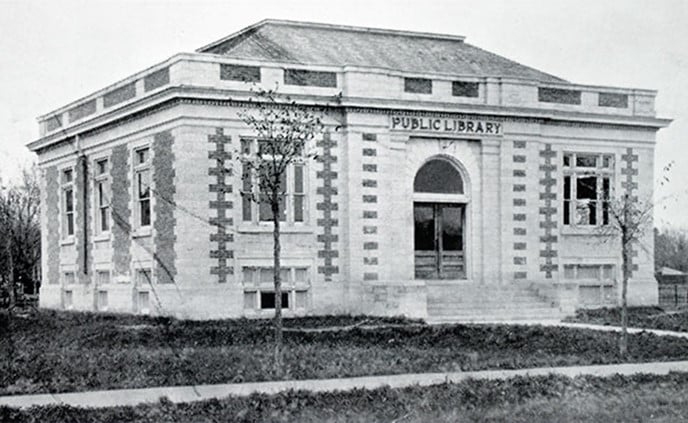
The library and reading room soon became a busy place. 714 books were checked out in February 1906 alone. The library also included a selection of newspapers from around the province, and two chess boards which attracted visitors that would come and spend hours at a time.
Soon, Selkirk’s library and reading room needed a larger location, and the town turned to Andrew Carnegie for help.
Selkirk’s Carnegie Library
Andrew Carnegie, the American industrialist turned philanthropist, funded the construction of more than 2,500 libraries around the world between 1898 and 1918. Selkirk’s town council and literary association would have been quite familiar with these grants, as Winnipeg built its central library on William Avenue in 1904 – 1905 using Carnegie’s money.
There were four Carnegie libraries in Manitoba. Winnipeg’s Central Library, which opened in 1905 and was expanded with another Carnegie grant around 1908. Winnipeg’s St. John’s Library (1915) and Cornish Library (1915) were also Carnegie funded.
Though generous, Carnegie’s grants came with conditions. He paid for the construction costs, but the grant recipient was responsible for finding a location and getting the structure built. It also had to commit to fund the library’s annual operating cost and ensure that the facility was ‘free to all’, meaning that there would be no entrance, membership, or check-out fees.
It is unclear if it was the town council or the literary association that made the application to Carnegie’s foundation, but it was announced on January 15, 1908 that Carnegie had offered a $10,000 grant towards the construction of a library. Council agreed to accept the offer and pledged to spent up to $1,000 annually to run it.
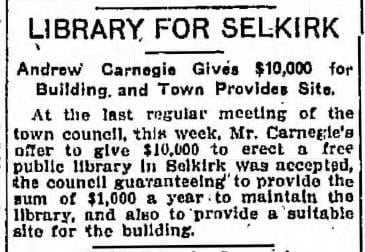
Architect William Fingland was asked to design the new building. Born and raised in Ontario, Fingland graduated from the University of Toronto and practiced in Baltimore, Maryland, and New York City before coming to Winnipeg in 1905. He has dozens of buildings to his credit across the prairies and was noted for his use of the Beaux-Arts classical style and decorative terra cotta detail.
Fingland was already known in Selkirk, as he had just designed two of its other public buildings; Central School and Selkirk General Hospital.
The town wasted no time getting construction underway. The design was finalized in June 1909, and a newspaper report from late October of the same year mentions that the brickwork was nearly complete, and the roof was being installed. In early November, workers got started on the interior. It is unclear who the contractors were. Newspaper from the time only mentions that Messrs. Miller and Franks were the electricians.
The new Selkirk Public Library opened in early June 1909. It contained two reading rooms on the main floor (one for each gender), plus a boardroom and the library stacks. The full basement held the mechanical room and space to create a small pool or gym in the future. The furniture for the library was donated once again by Captain William Robinson.
A library board was created to oversee its operations. Florence McDonald continued her role as a librarian until she married in 1919. After her, it was Charles Hunt, Mrs. Jenson, W. W. (Matt) Bennett (1948 – 1957), and Mrs. A. Law (1957 – ?).
The new library became a community hub and a popular place to hold meetings. Over the decades, groups such as the general hospital’s women’s auxiliary, bowling club, and board of trade used it extensively. In the late 1920s — from about 1926 through 1928 — it hosted the monthly town council meetings. Through the 1940s, it was home to both the district’s Boy Scout troupe and Selkirk’s first kindergarten classes.
Library usage began to drop off in the 1950s. Librarian Matt Bennett told Selkirk Enterprise columnist and historian Ruth Hooker in 1957 that just 600 – 700 of its 6,000 books were checked out each month. He blamed the growing popularity of radio and television. With the decline in visits, the library’s two reading rooms were rented out to other civic organizations.
Post-War Demolition and Relocation
In the late 1950s, the library building fell victim to a civic redevelopment scheme.
Rapid post-war growth in Selkirk meant that there was a need for a larger municipal building and new fire hall. With the library owned by the town and Central School expected to be vacant by the end of the decade, as described in a Selkirk Enterprise editorial: “… a plan began to take shape whereby the entire block between Main and Eveline would become a civic building.”
The library was torn down in April 1959 after the town was able to secure a grant from the federal government to demolish it as part of the civic centre expansion. Mabel Vogen, social editor of the Selkirk Enterprise, wrote in her April 15, 1959 column: “Our dear old library building is rapidly being demolished. I, for one, hate to see it go as we were always so proud of it.”
The rubble from the building was offered to the parks board for park improvements. Its timbers were used for furniture and out-buildings, and its bricks for paths and barbecue pits.
The library temporarily moved into the Central School, which would be vacated when Robert Smith School opened in the fall. When the newly expanded Selkirk Civic Centre opened in August 1960, the Selkirk library reopened there.
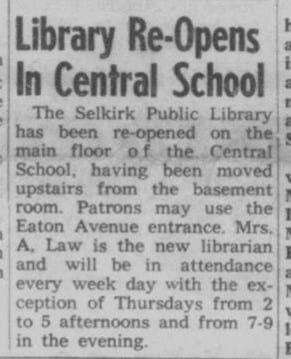
Selkirk Library Collection
Sources
Fingland, William – Biographical dictionary of Architects in Canada
Selkirk Enterprise, 1927, 1928, 1954, 1957, 1959
Selkirk Journal, 1928
Selkirk Public Library, 1913 – Archives of Manitoba
Selkirk Record, 1902
Who’s who in western Canada : a biographical dictionary of notable living men and women in Western Canada Volume I, Parker, C. W. (Charles Wallace)
Winnipeg Free Press, 1897, 1901, 1906, 1908
Winnipeg Tribune, 1903, 1908, 1923






